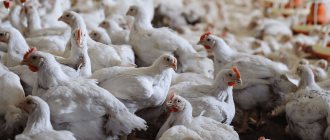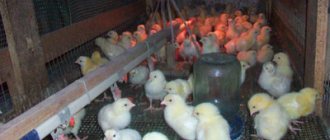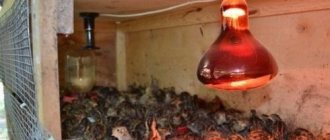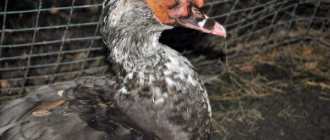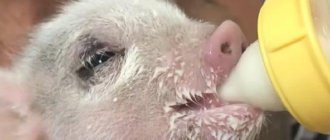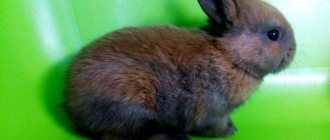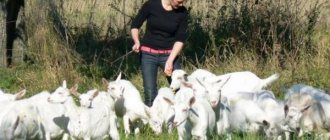How to measure the weight of a broiler?
Body weight is measured at least once a week, preferably daily.
The procedure is carried out at the same time, before feeding. The farmer can use steelyard, electronic or mechanical scales.
Small chicks are placed in a box one at a time and a measuring device is installed on top (after weighing the container).
Adults can be placed in a strong bag or sugar bag. It is recommended to cut holes at the bottom for the paws so that the bird does not move.
How to prepare feed at home
Broiler chickens do not need to be fed factory feed. If poultry farmers have free time and opportunity, they often prepare feed on their own, as they believe that the quality and taste of broiler meat deteriorate from factory feed.
In this case, breeders prepare mixtures and mashes from natural ingredients. However, homemade feed is much more expensive than purchased feed, and raising broilers is less profitable.
In addition, when preparing a daily menu for your feathered pets, it is not always possible to balance it so that the chicken receives all the necessary minerals and vitamins every day.
The following ingredients are often added to homemade mixtures:
- Wheat;
- oats;
- corn flour.
Grain crops should be crushed, and the grinding should be coarse. Milk, cottage cheese, yogurt, fish products, various vegetables and root vegetables, and fruit crops are also added to such foods.
It is also necessary to introduce into such feed a vitamin complex for the growth of broilers, which is necessary for the chicks to properly develop and strengthen the immune system.
All components are mixed in the following ways:
- You can knead the ingredients dry, then this dry food is placed in the chicken feeders;
- You can also prepare mash - dry ingredients are diluted with meat broth, milk, whey or skim milk. Moreover, any liquid is added immediately before feeding the chicks.
Important! The amount of food for chickens should be prepared directly for one feeding. Birds should eat it without leaving a trace. After feeding, all feeders should be washed thoroughly.
It is better to throw away leftover food so that it does not sour and spoil. Sour food should not be given to broiler chickens. Diarrhea or other health problems may occur.
Broiler growth and nutrition
The nutrition of broiler chickens depends on the age and fattening stage at which the bird is.
The following periods are distinguished:
| Phase | Age, days | Feed rate, grams | Products |
| Prestart | 0-5 | 15-20 | Millet, oats, boiled eggs, semolina, barley. Most of the feed is grain |
| Start | 6-18 (up to 30) | 25-90 | Grain, boiled egg, chopped greens, grated carrots and pumpkin, peas, soybeans, cottage cheese, corn, wheat, curdled milk, milk, vitamins |
| Fattening | 19-37 (up to 60) | 90-160 | Add chalk, boiled potatoes, fish, bone meal, bread yeast |
| Finish | 38-90 | 160-170 | They are fed solid food using the products already listed. Protein is removed, the volume of greens is significantly increased |
The frequency of feeding also depends on age.
You must adhere to the following frequency:
- 1 week – 8 times a day;
- 2 week – 6 times daily;
- 3 week – 4 times a day;
- 4 weeks until slaughter – twice a day.
The feed used in feeding can be in the form of dry granules of various fractions, or wet, when all products are soaked in milk, broth or whey.
The volume of liquid consumed in relation to feed is 1.7:1. It is recommended to feed the bird a solution of potassium permanganate to prevent gastrointestinal diseases.
Mistakes in feeding broiler chickens
The first mistake lies in keeping the chickens. This is an important detail in raising poultry that is always worth remembering. Because even with proper feeding, problems cannot be avoided if maintenance standards are violated.
In order for the chicks to eat their daily amount of food, it is necessary to ensure, first of all, normal living conditions. The room must be clean. Where the chicks are located, it is worth maintaining a certain temperature regime. Moreover, this applies not only to the temperature in general, but also to the floor, which should also be warm enough. You must be sure of this and, if it is cold, take measures to insulate it.
There should be no moisture, much less mold, in a chicken coop with young animals. The premises should be carefully checked for their presence and corrective measures should be taken.
Important! The lighting should not be too bright. The room must have good ventilation. The second and very important mistake is feeding
Chickens should be given only high-quality, fresh feed as food. The diet must be balanced and rich in vitamins, otherwise the bird will get sick and lose weight
The second and very important mistake is in feeding. Chickens should be given only high-quality, fresh feed as food. The diet must be balanced and rich in vitamins, otherwise the bird will get sick and lose weight.
Chicken feed
The third mistake is that they try to feed broilers like regular chickens. This should under no circumstances be done if the breeder does not want to incur losses. To get started, chicks simply need to receive food rich in nutrients and minerals. The entire range of necessary substances is available in special feeds.
By following all these recommendations, raising healthy chickens and making a profit from them will not be difficult. Broilers have long gained popularity due to their rapid growth and tender, tasty meat. Where to put the carcasses and make a profit is not a problem. The sales market is quite large, and prices are constantly rising, but despite this, consumer demand does not decrease.
Table of weight gain by day
The gain of live body weight of broilers by day depends on the breed, sex of the bird, and conditions of detention. The weight gain of hens is slower than that of roosters. The norm for daily weight gain is not less than 60 g.
On average, the weight should correspond to the following indicators:
| Age, days | Weight, grams |
| 40-45 | |
| 1 | 50-60 |
| 2 | 65-80 |
| 3 | 85-95 |
| 4 | 100-115 |
| 5 | 120-135 |
| 6 | 140-165 |
| 7 | 170-190 |
| 8 | 200-220 |
| 9 | 230-250 |
| 10 | 260-280 |
| 11 | 300-325 |
| 12 | 345-370 |
| 13 | 380-420 |
| 14 | 440-460 |
| 15 | 485-520 |
| 16 | 540-565 |
| 17 | 580-630 |
| 18 | 650-690 |
| 19 | 720-750 |
| 20 | 780-820 |
| 21 | 850-890 |
| 22 | 920-970 |
| 23 | 1 000-1 030 |
| 24 | 1 070-1 100 |
| 25 | 1 150-1 200 |
| 26 | 1 230-1 270 |
| 27 | 1 300-1 350 |
| 28 | 1 400-1 450 |
| 29 | 1 480-1 500 |
| 30 | 1 550-1 580 |
| 45 | 2 000-2 500 |
| 60 | 2 500-3 000 |
Conditions of detention
Here are the basic standards for floor housing for broiler chickens.
- The stocking density in the absence of forced ventilation is 10-15 birds per square meter. m. If there are fans, then up to 20-25 heads. At the end of fattening, it is undesirable to keep more than 40 kg of live weight per square meter.
- The temperature for broilers at one day of age should be 32-33 °C, then it is gradually reduced to 18-20 °C. Below is a table of temperature conditions used for industrial keeping of broilers on the floor.
| Age, days | Temperature, °C |
| 0-7 | 33-30 |
| 8-14 | 29-27 |
| 15-21 | 26-24 |
| 22-28 | 23-21 |
| 29-35 | 20-19 |
| Over 35 | 19-17 |
There are slight differences for the brooder system.
- Drafts are not allowed, especially in the first week of cultivation.
- Illumination. When planting day-old chicks, it should be 40-50 lux so that all the babies find food and water. Then it is gradually reduced to 10-15 Lux. This can be done by turning out the light bulbs from the lampshades or replacing them with weaker ones.
- The duration of daylight hours for broilers on the first day is 23 hours. Then the period of darkness is increased to 4-6 hours at night. Longer sleep is not recommended for fattening broilers, since in this case they gain body weight worse.
- Ventilation. When housing is crowded, it is necessary to force air into the room. To do this, exhaust fans are installed in the walls. They should provide air exchange at a level of 0.5-1 cubic meters. per head in winter and up to 5-7 cubic meters. during the heat.
Humidity is maintained at 55-70%.
Remember that no thermometer can replace careful observation of your chicks. Monitor the behavior of the bird and respond to its dissatisfaction in a timely manner.
Here are some tips for assessing chick behavior:
- the chickens are huddled together all over the poultry house - they are cold;
- the heaps are unevenly distributed, the birds flock to one side - there are drafts;
- the chickens have opened their beaks and are breathing heavily, spreading their wings - they are hot;
- chickens have a large and hard crop - there is not enough water;
- The crop of 20% of birds (or more) is empty - there is not enough food.
The simplest bunker feeder. Here the food is placed into the container from above and, as it is eaten, it moves downwards under its own weight.
Causes of poor weight gain
Sometimes the bird’s body weight growth lags behind the established standards.
The reasons for the situation may be related to:
- insufficient caloric content of feed;
- poor quality of food ingredients;
- low temperature in the room or its changes, when energy is spent on heating the body;
- lack of lighting (should be around the clock for chickens under 1 month old, for older ones - 14 hours a day), details about the light regime for broiler chickens;
- large walking area (calories consumed are burned when moving);
- vitamin deficiency;
- damage by helminths or infectious diseases;
- lack of a meal schedule, which disrupts metabolic processes in the chickens’ bodies.
The room temperature at which the chicken is comfortable and the calories consumed are not spent on self-heating should be as follows:
- 0-14 days – +30 degrees;
- from 2 weeks – +25 degrees, with a decrease of 1-2 degrees every subsequent week.
The number of chickens is no more than 13-18 birds per 1 m², this will eliminate the waste of the energy value of the feed on unnecessary movements.
Features of feeding
Depending on the age of the broiler chicken, there are three main stages in its nutrition:
- Starting - from hatching to reaching 2 weeks. At this stage, it is necessary not only to feed babies with high-quality food, but also to strengthen their immunity. To do this, you need to give chickens more vitamin and mineral complexes, as well as carry out routine vaccination.
- Growth - lasts from 2 to 4 weeks. Characterized by active growth of young animals. Therefore, at this stage it will be necessary to ensure that a sufficient amount of protein food (both animal and plant) enters the chicks’ body.
- Finish - after 4 weeks. During this period, the taste of meat is formed. Therefore, it is necessary to provide one-month-old broilers with the most natural nutrition possible. In this case, you will need to remove synthetic additives and specific foods (for example, fish) from your diet.
In order for the meat to acquire a delicate “milky” taste, it is recommended to add fresh bread to the broiler’s feed a few days before slaughter.
Choosing a balanced diet for feeding broilers is half the battle. It is also necessary to organize proper feeding for the birds. In order for chickens to grow quickly and gain weight, several simple conditions must be observed:
- There should always be plenty of fresh water in drinking bowls. In summer the liquid may be slightly cool, in winter it may be at room temperature.
- To fatten quickly, chickens must feel comfortable. Therefore, the optimal temperature regime should be maintained in the chicken coop. For babies up to one week of age, the indoor temperature is required to be 31-34°C, from 2 to 3 weeks - 25-30°C, older - 20-23°C. Sudden temperature changes also have a negative impact on the health of livestock.
- Broilers gain weight better when there is good lighting. For newly hatched chicks until they are a month old, the coop light should be on 24 hours a day. From 1 month of age, the optimal length of daylight hours is 14 hours.
- Young animals need to be fed strictly according to the schedule, observing equal intervals between meals. This is necessary for the normal functioning of the digestive system.
- It is necessary to avoid crowding during feeding. There should be at least 3 cm of feeder per chicken.
- For the fastest fattening, it is better to limit the physical activity of broilers. To do this, you should not move the livestock into a chicken coop that is too spacious, and also reduce the time spent walking in the fresh air to 2-3 hours a day.
- It is necessary to moisten the feed before feeding it into the feeders. This is necessary to dissolve artificial amino acids and vitamin supplements.
- Broiler food should always be fresh, especially wet mash. Sour or rotten feed will lead to poisoning of the livestock. As a result, the weight of the chickens will not increase, but rather decrease.
Also, to quickly gain body weight, it will be necessary to periodically treat birds against helminths. Parasites negatively affect the general well-being of chickens, “rob” them of some of the nutritional compounds, and also often become the cause of certain diseases.
It is much easier to fatten broilers in the warm season than in winter. This is due to the presence of a sufficient amount of greens, fruits and vegetables. Fresh plant foods are a natural source of vitamins and also promote good bowel function.
Answers to common questions
Most poultry farmers' questions relate to choosing the appropriate breed and age at which to slaughter the bird.
What is the slaughter weight of broiler chickens?
Broilers are slaughtered at the age of about 50 days, less often at a later date. A bird that reaches 70 days stops gaining weight and there is no point in raising it any further.
It is better to slaughter when the chicken is sufficiently feathered, then the carcass will become cleaner and easier to pluck.
By the time of slaughter, a chicken reaches a weight of approximately 2.7-3 kg, some birds of especially meat breeds - up to 5 kg. Approximately 17-18% of the mass falls on the pectoral muscles, 9-10% on the thigh muscles, 6.5% on the lower leg.
What breed of broiler is the largest and meatiest?
All birds reach impressive dimensions by the time they are slaughtered, but they also have their own leaders.
The largest breeds include:
- Ross-308. By the age of 2 months, the individual reaches an average weight of about 2.5 kg, the maximum possible weight is 5.5-6 kg. Meat yield during cutting is up to 74%. The breast is wider and meatier than that of representatives of the Koob breed, but Rosses have weaker immunity. The color of the skin and flesh is pale. They have good egg production.
- Ross-708. It is characterized by high early maturity. By 1 month of life, the bird reaches a weight of 2.5-3 kg. The body is squat and powerful. The color of the skin and meat is yellowish; if slaughter is carried out at an early age, the tone is light. Good egg production.
- Koob-500. Chickens reach 2-2.5 kg by the 6th week of life. The meat and skin of representatives of the breed are not pale, but have a more natural yellowish tone. They are distinguished by a wide chest and powerful legs. Survival due to the body's resistance to disease reaches 98%. Exclusively meat breed.
- Hubbard. By 2 months, individuals reach a weight of 2.7-3.2 kg, the maximum possible figure in adulthood is 8-10 kg. The body is medium in size, the chest is well defined, especially in females. Satisfactory egg production. Survival rate is up to 99%.
How and what to feed broiler chickens at home
Greetings, readers and guests of the “all-about-chickens” site. As you know, a broiler is a breed of chicken that gains weight very quickly. In just 2 months, the weight of a broiler chicken can reach 2 kg or more. Let's look at how and what to feed broiler chickens at home.
What to feed broiler chickens in the first days
Feeding newly hatched chickens is a job that will seem quite complicated to beginners in this business, but this is not at all the case, you just need to remember some conditions and features. In order for young animals to quickly gain weight, you need to follow the rules of watering and feeding. For good and quick weight gain, chickens resort to the use of compound feed.
Feeding broilers includes: pre-start – start – fattening – finish. Let me explain: “pre-start” is fed during the first seven days, after which the chickens are transferred to “start”. After ten days, the diet of the children goes into the fattening phase, and after 2.5 - 3 weeks, the broiler chickens are transferred to the “finish” feed.
Remember that it is impossible to raise healthy chicken on feed alone; you must add vitamin supplements. On the first day, you need to give young chickens enrofloxacin (according to the instructions) or use a pipette to drop a drop of vodka into the open beak of each chicken for 3 days.
By the seventh day, they begin to give Chiktonik and Biovit, which accelerate growth and prevent hypovitaminosis.
Following these recommendations, out of 50 chickens, 48 will definitely be healthy and strong after 4 months, weighing at least three kilograms (hens) and four kilograms (cockerels).
Chickens are fed with specialized feed until they are one month old, and then switched to natural food. Such a change in diet will improve the taste of meat and significantly save your money.
If it happens that some chickens eat poorly and lag behind their peers in weight gain, then they should be separated from the rest and fed with milk with egg yolk mixed in for several days. Once the situation is corrected, these individuals can be returned back to the family.
You need to constantly drink from drinking bowls, not from lids and bowls, as babies can get wet, which often leads to their death.
For broiler chickens from two weeks of age, boiled potatoes are added to the diet, but not in pure form, but not very much with anything else, grated pumpkin, grated carrots, greens in the form of dandelions, nettles and just chopped grass. They begin to add greens a little at a time, gradually increasing their volume. Finely chopped eggshells and chalk are also added to the diet in separate bowls.
What to feed broiler chickens from two weeks
When the chicks are 2 weeks old, the amount of feed is increased. You can give boiled fish, minced through a meat grinder mixed with feed. They feed boiled and twisted liver.
Compound feed is gradually replaced with a chopped mixture of peas, barley and corn + complementary foods from your table. They also begin to feed the grown-up chickens with wet mash (steamed oats and barley).
I note that dry food and fresh water should be available around the clock, and mash should be prepared immediately before feeding, as well as table waste. They make sure that the chicks do not eat sour food. It will be useful to add yeast and eggshells to table food.
https://youtube.com/watch?v=FYPON33jPyI
Grass for broilers is a separate important part of the diet, since these chickens quickly gain weight and need enhanced vitamin support. Broilers eat various greens throughout fattening. At the beginning, the grass is added in small portions in crushed form and often mixed with mash or mixed feed, then its quantity is increased and separated into a separate feeding.
In the autumn, radish tops, cabbage leaves, zucchini and pumpkin are used in addition to the variety of greens.
To keep broiler chickens in winter, it would be good to stock up on dried hay of various herbs, dry nettles and prepare pine flour.
What not to feed broilers
To avoid illness and death of chicks, exclude beets from the diet of broiler chickens, because it causes diarrhea, which makes it difficult to gain weight. Spoiled and sour products and mashes, soaked bread, any sausages, alcohol and fermented food are not allowed; young animals should not be fed chocolate, jam, or citrus fruits. Also exclude vegetable oil and butter.
More interesting articles on our website:
https://vse-pro-kur.ru/
Care instructions
A broiler chicken requires more careful care than a regular laying hen. A warm poultry house and a clear daylight regime are important.
The room is washed and whitened, drinking bowls and feeders are installed, lighting and heating are provided, and a thermometer is installed. A blanket of sawdust is placed on the floor.
For the first 2 weeks, round-the-clock lighting and a temperature of + 30 degrees should be provided. Subsequently, reduce the temperature by 2 degrees per week to +22 °C.
When the broilers are 1 month old, the daylight hours should be 14 hours, and the lighting should be turned off for 10 hours.
There should be no more than 13 heads per 1 m2. If the livestock is larger, the barn should be equipped with cages.
On a note . The floor in the chicken coop should always be dry and clean. Humidity can make the bird sick.
Suitable foods
Use after 2 months, until the slaughter of the bird.
Various mixtures are also prepared at home.
Two-month-old broilers are fed wheat, greens, and vegetables and fruits are added to their food.
Cooking rules
Caring for chicks also includes preparing their own food. Many people think that ready-made feed slightly degrades the quality of the resulting meat. Many people choose to make their own from natural ingredients. In this case, the care and maintenance of broiler chickens becomes several times more expensive compared to ready-made feed.
Diet of monthly chicks
What is suitable for food
What to feed one month old broilers? We have already learned that for each age of the bird its own properly organized diet is important. Of course, you can make feeding broiler chickens traditional, like feeding other chickens, but in this case the main goal - weight gain - will remain unachieved. Beginning farmers need to understand that every day of a bird’s life should bring weight gain, and for this you need to properly organize the feeding of the chicks. So what to feed broiler chickens at 1 month?
After reaching the age of 30 days, broilers are no longer fed with starter feed. Although some extend its use to 2 months. Experts recommend switching pets either to the second type of the above-mentioned food, or adding natural ingredients. This will only play into the hands of the owners and significantly improve the taste of poultry meat. The diet of a chick that has reached the age of 1 month must be enriched with crushed grains or a mixture of them, which will include:
In order not to get confused about the acceptable proportions, experienced poultry farmers combine equal parts of these ingredients, mixing them with broth and adding fish oil, sometimes with cottage cheese.
Interior arrangement of the chicken coop
After successful construction of the premises, you should begin to arrange the interior: create a warm bedding, install feeders with drinkers and organize protection from winter cold and pest (rodent) invasions.
Litter
The flooring in the chicken coop simultaneously performs several important functions:
- creates thermal insulation of the floor;
- material mixed with droppings disinfects pathogenic bacteria;
- protects chicken feet from dampness and cold.
The constant and best material, as a rule, is sawdust, which at first is sprinkled with straw or peat crushed to 5 cm. In summer, the thickness of the formed litter should be 6–10 cm, in winter – at least 15 cm.
Gradually, as the chickens grow older, new litter is added to the wet areas. A complete replacement of the floor covering is carried out after its thickness reaches 35 cm.
Important! It is not recommended to exceed the specified thickness. An overly grown bedding layer is poorly ventilated, condensation accumulates inside and mold, which is dangerous to the health of broilers, appears. By increasing the bedding, broilers can comfortably and productively sit out the winter cold characteristic of the middle zone, however, in addition to creating floor “protection”, you should think about the general insulation of the constructed poultry house:
By increasing the bedding, broilers can comfortably and productively sit out the winter cold typical of the middle zone, however, in addition to creating floor “protection”, you should think about the general insulation of the constructed poultry house:
- The walls of the building are insulated with polystyrene foam, penofol, basalt or mineral wool.
- The roof is made of felt, polystyrene foam and waterproofing materials. The previously installed roofing material will also serve as excellent protection.
The process of insulating the chicken coop should be carried out in advance, no later than September–October.
Rodent protection
The previously outlined construction plan and step-by-step instructions provide for closed access to the chicken coop (due to a stretched mesh that fits tightly to the ground) for rodent pests, however, for complete confidence in protection, it would not hurt the farmer to follow a number of additional rules:
- the door to the chicken coop should be tightly closed at night;
- the room must be regularly ventilated;
- it is necessary to promptly clean and disinfect feeders and drinkers, general sanitation, and remove excess garbage;
- good access to daylight and artificial light is important;
- Aromatic plants should be placed around the poultry house and the adjacent aviary - chamomile, mint, wormwood;
- chickens should feed outside; food supplies should not be left indoors overnight.
Installation of feeders and drinkers
Food equipment for meat-oriented chickens can be made from:
- wood;
- plastic;
- nipple;
- metal;
- glass
Main requirements:
- bottom tightness;
- smooth (polished) surface;
- ease of cleaning and disinfection.
In winter, drinking and food equipment is located directly inside the chicken coop, and is attached to the walls of the building in the same way as in the summer to the fence.
Consequences of poor nutrition
Due to improper feeding, diseases can develop:
- The most common ailment is chickens falling on their feet. This disease develops as a result of a deficiency of calcium and vitamin D in the bird’s body. For the same reasons, they develop rickets.
- Poor nutrition often leads to diarrhea. Growth slows down with a lack of vitamin A. The reserves of this group of vitamins are replenished by adding carrots to the diet.
- The occurrence of seizures is a sign of a lack of vitamin E, in which case you need to feed with wheat germ. B vitamins are replenished by eating greens at all stages of broiler life.
What to do if broilers do not grow?
Broiler chickens are specially created for meat production. Their feature is the rapid growth of muscle tissue. Representatives of meat breeds are suitable for slaughter at 1.5–2 months. These birds are demanding on the quality of feed and living conditions. If broilers are not growing, the farmer needs to find out what the problem is. The slow growth of chickens may be associated not only with errors made when preparing the diet of birds, but also with other factors.
